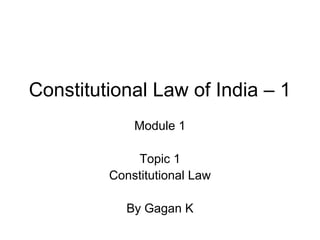
Constitutional Law of India Module 1 Overview
- 1. Constitutional Law of India – 1 Module 1 Topic 1 Constitutional Law By Gagan K
- 2. Syllabus Module 1 – Constitutional Law – Constitutionalism – Rule of Law – Historical Perspective – Salient features – Fundamental Law Module 2 • Fundamental rights – Concept, Magna Carta, English Bill of Rights, American Bill of Rights, UDHR • Need for Fundamental Rights (FR) • Art. 12 and FR • Justifiability of FR (Art. 13) • Doctrine of eclipse • Doctrine of severability • Waiver of FRs • Right to equality
- 3. Social Contract theory • Thomas Hobbes in his book “Leviathan” (1651) says about “state of nature” – Where the life of man is “solitary, poor, nasty, brutish and short” – Because of absence of political law and order – Because of unlimited freedoms including freedom to plunder and murder others. – “Bellum Omnium Contra Omnes” (latin) means “war of all against all”.
- 4. Hobbes’s Social contract (cont) • Men then thought about ideas on ending such “never ending misery and violence”. • Men made a contract with each other within that society. This is what Hobbes calls as “social contract theory”. • All men compromised certain of their rights / freedoms in lieu (return) of security and protection. • All of them subjected themselves under a sovereign or group of men who would provide them security and protection. • Hobbes, Locke, Rousseau and Rawls – all belong to the social contract theory tradition.
- 5. We… The People • Is Constitution of India also a type of social contract? • Just examine the words in the Preamble “We the people having solemnly resolved to constitute…. And secure all its citizens equality, fraternity, justice…. We give ourselves this constitution…” • Don’t these words embody the principle of “social contract”?
- 6. 1. Constitutional Law Taken from MP Jain
- 7. Functions of a modern State • Unlike the ancient Governments that concentrated only on “police functions” i.e providing security… modern govts have varied and expansive functions. • Modern States are “welfare States” • They perform multiple and varied functions • So many functions are distributed among various organs • These organs will have certain powers, functions, responsibilities and duties. And more importantly “inter relations” • A Constitution lays down the rules and norms for these organs.
- 8. Legal system of every country • 1. Law Governing the State – Constitution – Administrative Law – Public International Law • 2. Law by which the State governs the members – Contracts, Torts, Property law, Civil Law
- 9. Scope of Constitutional Law • Constitution of India only provides the basic framework required for the governance of the country (despite being a bulky document) • Details – such as the sundry rules are not given in the Constitution • Details are given in the statutes, Acts, rules, decisions of the courts and conventions. • For example: Election Commission is constituted under the Constitution. The rules of functioning of the commission are given in Representation of People’s Act • Constitutional law is broader than the Constitution. (that is – the Constitutional text)
- 10. Organs • 1. Legislature – makes the laws • 2. Executive – executes / implements / enforces the laws • 3. Judiciary – interprets the laws • Constitutional law is concerned with laying down the rules governing the power relations between these organs • Apart from these 3 organs, there are other organs created by our Constitution – like UPSC, Election Commission etc.
- 11. Fundamental Rights • Fundamental Rights (hereinafter referred as FR) – FRs are guaranteed under the Part III. • These are inherent rights of the people • Inalienable • Judiciary is the protector of these rights • Any law violating the FRs is unconstitutional (null and void) • Study of FRs constitutes the major chunk of our study
- 12. Conventions • Non-legal rules • Keeton said “in the absence of conventions, there may be a bloody revolution” • Justice Ahmadi said “conventions are - – Long standing – Accepted practice – Arises where law is silent – And do not violate existing laws • Conventions have less prominence in written constitutions • In UK (unwritten constitution) has more promimence • In India, it has persuasive value
- 13. Written v. Unwritten Constitution • Written – in black and white. Proof, fixed, certain • Unwritten – leads to confusions and uncertainty at times • With unwritten Constitutions, the role of courts in interpretation is wider • Written Constitutions have amendment procedure provided • Written Constitutions also limit unlimited power
- 14. End of topic 1 within module 1
- 15. Constitutional Law of India slides by Gagan Krishnadas is licensed under a Creative Commons Attribution- NonCommercial-ShareAlike 4.0 International License gagan555@gmail.com
